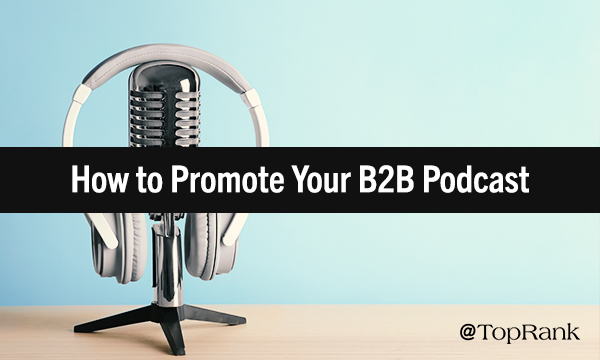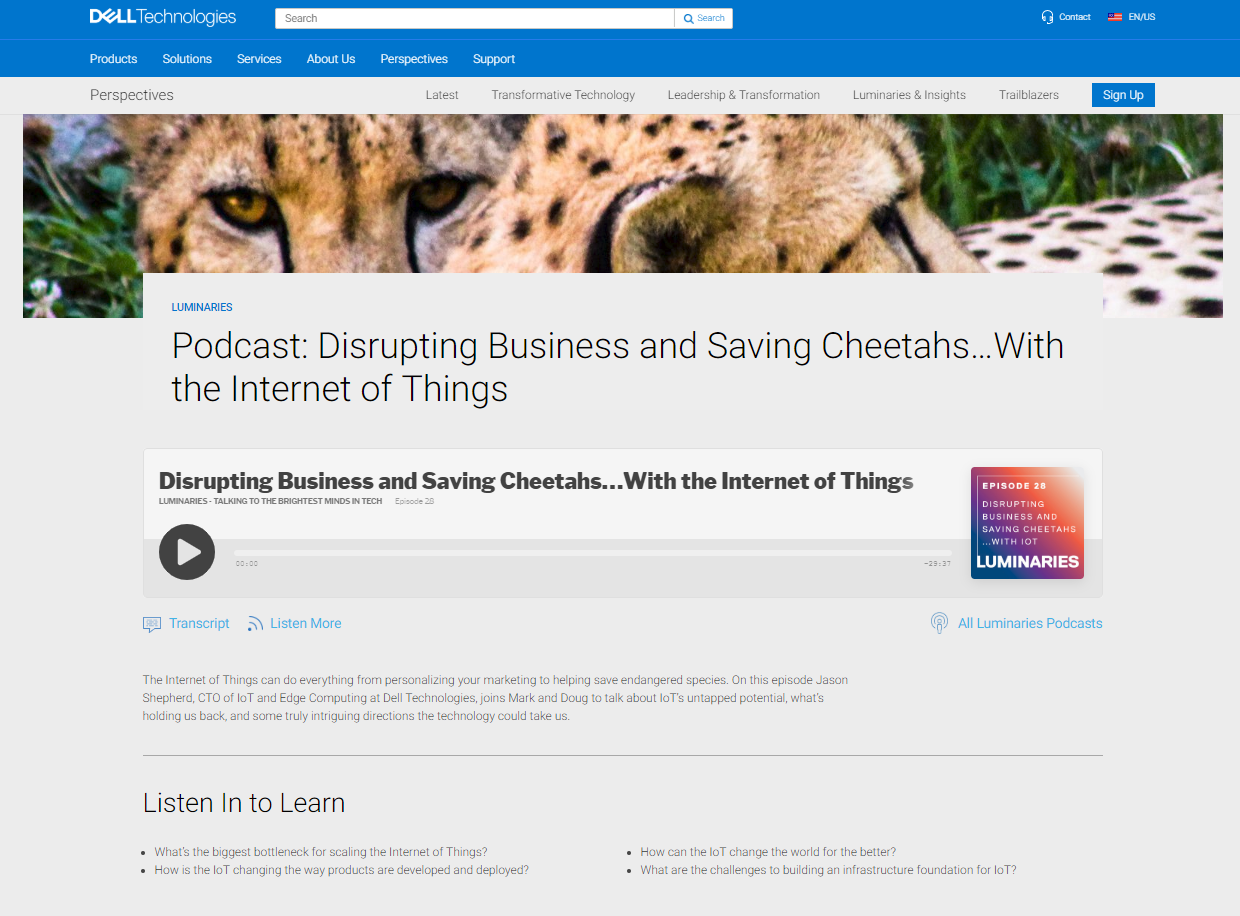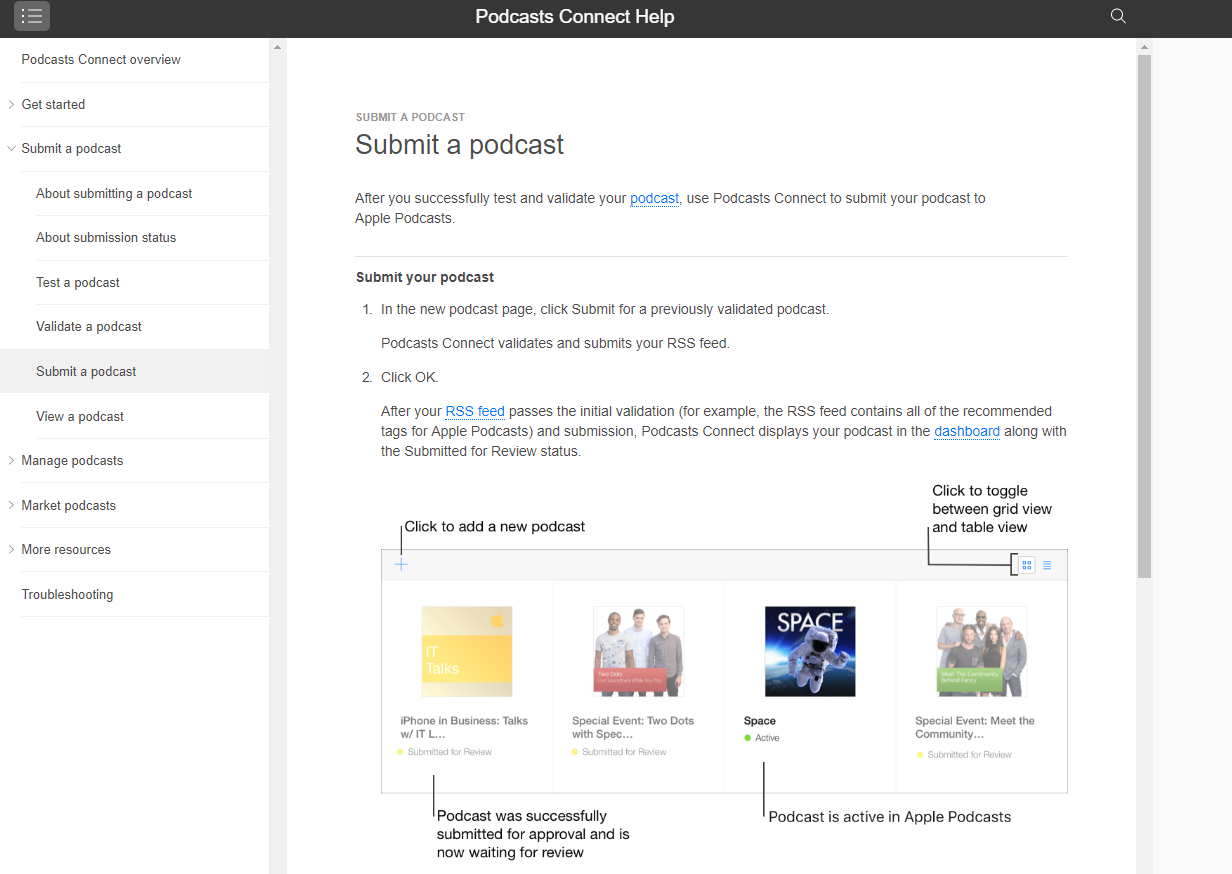
 Over 1/4th of the entire population of the United States listens to podcasts at least monthly. That's over 81 million people. What's more, the most avid listeners log six and a half hours a week of listening time. Eighty percent finish every episode in its entirety. There's enormous potential here for engaging an audience. Think about how long someone might stick with a 1,000 word blog post (like this one). Five minutes? Ten? But they might listen to a 25-30 minute podcast on the same topic. Podcasting holds a lot of promise for marketers, especially in the B2B space. Our agency has helped multiple B2B Fortune 500 companies produce and find an audience for their podcasts. It takes strategy and coordination, but the barrier to entry is relatively low. Of course, "making" the podcast is the easy part. As with any content, the challenge is successfully getting it to your target audience. Here are a few things we've learned about B2B podcasting promotion through our production and amplification work.
Over 1/4th of the entire population of the United States listens to podcasts at least monthly. That's over 81 million people. What's more, the most avid listeners log six and a half hours a week of listening time. Eighty percent finish every episode in its entirety. There's enormous potential here for engaging an audience. Think about how long someone might stick with a 1,000 word blog post (like this one). Five minutes? Ten? But they might listen to a 25-30 minute podcast on the same topic. Podcasting holds a lot of promise for marketers, especially in the B2B space. Our agency has helped multiple B2B Fortune 500 companies produce and find an audience for their podcasts. It takes strategy and coordination, but the barrier to entry is relatively low. Of course, "making" the podcast is the easy part. As with any content, the challenge is successfully getting it to your target audience. Here are a few things we've learned about B2B podcasting promotion through our production and amplification work.
How to Promote Your B2B Podcast
Some of the tactics you will use to amplify your podcast are familiar, but the channel does have unique properties that require new approaches. We’ll start with adapting traditional tactics, then we’ll finish with the podcast-specific ones.Adapting Traditional Promotional Tactics for B2B Podcasts
#1: Start with Audience Demand As with any content, your podcast should begin with research. See what questions your audience has, what they need to know, and what they want to hear. Aim to generate a topic list that highlights your brand’s expertise and your subject matter experts’ insights to create something of value to your audience. Once your research is complete, it's also well-worth documenting your findings, goals, and promotional plans in a creative brief. This will serve as a guide as you go forth and create. For Podcasts: Stay closer to top-of-funnel with your podcast ideas. It’s far better to educate, inspire, and entertain your audience than to try and sell them something. A 25-minute-long advertisement for your solution is likely to drive people away. #2: Add Influencers for Amplification We’re big believers in influencer marketing, and we have plenty of results to back that up. When you co-create content with influencers you get higher-quality, dynamic content that has built-in amplification. Here's an example from 3M's* Science Champions podcast, featuring the brand's own amplification of a recent episode as well as the influencer interviewee's amplification. For Podcasts: We've often found that many industry influencers and experts would rather do an audio interview than a written one. So it should be easy to get experts whom you have a solid relationship with to commit to a 30-minute interview, which can be recorded and processed into a podcast. If you're looking to work with new folks in the field, we recommend taking the time to nurture the relationship (e.g. like and share their social content, engage them in conversation on social or their blogs, or reach out via email to introduce yourself and let them know you're a fan of their work) before reaching out cold. Another way to incorporate an influential voice and extend the potential reach of your podcast is to tap industry influencers to host or co-host the podcast. The Dell Luminaries* podcast is a great example of this, featuring two thought leaders as hosts: Seasoned marketer and author Mark Schaefer and marketing and technology strategist Douglas Karr.
For Podcasts: We've often found that many industry influencers and experts would rather do an audio interview than a written one. So it should be easy to get experts whom you have a solid relationship with to commit to a 30-minute interview, which can be recorded and processed into a podcast. If you're looking to work with new folks in the field, we recommend taking the time to nurture the relationship (e.g. like and share their social content, engage them in conversation on social or their blogs, or reach out via email to introduce yourself and let them know you're a fan of their work) before reaching out cold. Another way to incorporate an influential voice and extend the potential reach of your podcast is to tap industry influencers to host or co-host the podcast. The Dell Luminaries* podcast is a great example of this, featuring two thought leaders as hosts: Seasoned marketer and author Mark Schaefer and marketing and technology strategist Douglas Karr.  When it comes to conducting the interview, use a tool like Zencastr to make sure you get high-quality audio. Unsurprisingly, audio quality is absolutely critical for a podcast endeavor. #3: Use Internal Promotion to Boost Awareness If you’re at an enterprise-level organization, you have a built-in audience. Encourage your employees to listen to each episode and share it with their social networks. For Podcasts: The first 2-3 weeks after publication are a crucial time to get your podcast seen. In addition to listening and sharing, encourage employees to write a review on iTunes and other podcast platforms. Reviews, especially on iTunes, play a big part in determining which podcasts the platform recommends to its existing users. #4: Optimize for Search As with written content, you’ll want to make sure you’re including keywords, a compelling visual, and a descriptive title on each episode. Use keyword research tools, existing analytics data, and other appropriate tools and resources to determine a list of target words. Then, test them out on podcast platform search engines to make sure you’re hitting the right intent. For Podcasts: Since search engines can’t crawl your audio, it’s doubly important to make every word count on your podcast description and title, episode descriptions and titles, and what categories you choose in podcast directories.
When it comes to conducting the interview, use a tool like Zencastr to make sure you get high-quality audio. Unsurprisingly, audio quality is absolutely critical for a podcast endeavor. #3: Use Internal Promotion to Boost Awareness If you’re at an enterprise-level organization, you have a built-in audience. Encourage your employees to listen to each episode and share it with their social networks. For Podcasts: The first 2-3 weeks after publication are a crucial time to get your podcast seen. In addition to listening and sharing, encourage employees to write a review on iTunes and other podcast platforms. Reviews, especially on iTunes, play a big part in determining which podcasts the platform recommends to its existing users. #4: Optimize for Search As with written content, you’ll want to make sure you’re including keywords, a compelling visual, and a descriptive title on each episode. Use keyword research tools, existing analytics data, and other appropriate tools and resources to determine a list of target words. Then, test them out on podcast platform search engines to make sure you’re hitting the right intent. For Podcasts: Since search engines can’t crawl your audio, it’s doubly important to make every word count on your podcast description and title, episode descriptions and titles, and what categories you choose in podcast directories.
Podcast-Specific Promotion Tactics
#1: Publish Transcripts as Blog Posts As I said above, search engines can’t crawl audio. And competition is fierce for visibility on podcast platforms like iTunes and Google Play. You can use your blog to help drive subscriptions, which will help your podcast gain traction. Make a post for each episode with a summary, key takeaways, and full transcription. Embed the podcast stream on the post, and make the CTA to subscribe to the podcast. #2: Commit to a Cadence Podcast promotion is all about building a habit for your audience. You want them to subscribe, stay subscribed, and listen to every episode. To make that happen, you need to publish consistently. It’s better to post an episode every two weeks for a year than to publish weekly and take a 6-month hiatus at the end. It’s best to start with at least three episodes available for download (required to make Apple’s New and Notable list) and several more to act as a buffer. Then you can determine the cadence that will enable you to publish without pausing. #3: Submit to Podcast Directories Much of your initial subscriber base will likely come from your existing audience, through your blog posts. But the goal is to build a subscriber base wherever people listen to podcasts, so you can capture a net new audience. To that end, it’s important to register your podcast with Apple Podcasts, Google Play Podcasts, Spotify, TuneIn, Stitcher, and Podbean. These platforms together account for the vast majority of podcast listeners. Registration on each of these services is free, and it makes finding your podcast a seamless experience for every user. #4: Look for Cross-Promotional Opportunities The majority of people who listen to podcasts don’t just listen to one. In fact, it seems the more podcasts someone listens to, the more likely they are to try out a new one. So you’re not trying to lure people away from someone else’s podcast to listen to yours — it’s not a zero sum game. Podcasting is therefore less competitive than other media might be. It’s worth checking with established podcasts to see if there are opportunities for cross-promotion. Subject matter experts in your company could appear on their podcast, or you could interview another host in a relevant industry for yours. Either way, both of your podcasts gain exposure to a new audience.
#4: Look for Cross-Promotional Opportunities The majority of people who listen to podcasts don’t just listen to one. In fact, it seems the more podcasts someone listens to, the more likely they are to try out a new one. So you’re not trying to lure people away from someone else’s podcast to listen to yours — it’s not a zero sum game. Podcasting is therefore less competitive than other media might be. It’s worth checking with established podcasts to see if there are opportunities for cross-promotion. Subject matter experts in your company could appear on their podcast, or you could interview another host in a relevant industry for yours. Either way, both of your podcasts gain exposure to a new audience.
Rise of the Pod People
Podcasting is one of the biggest marketing opportunities for B2B businesses right now. Even as saturated as the B2C market is, there’s still room for new breakout stars. By comparison, the B2B space has even more room to grow. It’s a channel that has yet to suffer from fatigue or content shock. As a content marketer, much of what you already know about content applies to promoting podcasts: Be relevant, be valuable, work with influencers, promote on social media, etc. With a few new tactics combined with the old standbys, you can make sure your podcast has everything it needs to find a long-term sustainable audience. Want to find out more about B2B podcasting and whether it's a fit for your B2B brand? Learn the what, why, and how of B2B podcasting by checking out my post on the subject. *Disclosure: Dell and 3M are TopRank Marketing clients.The post How to Promote Your B2B Podcast appeared first on Online Marketing Blog - TopRank®.
Article Source: http://bathseoexpert.blogspot.com/2019/05/how-to-promote-your-b2b-podcast.html
No comments:
Post a Comment